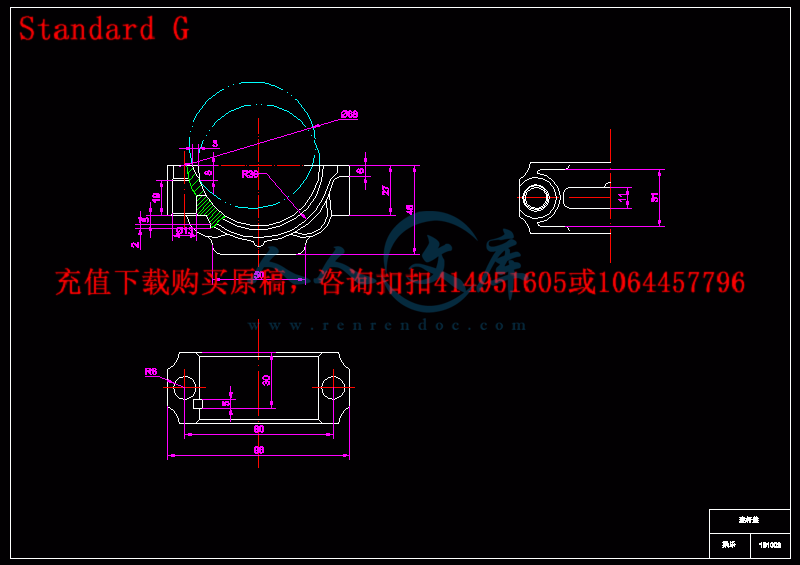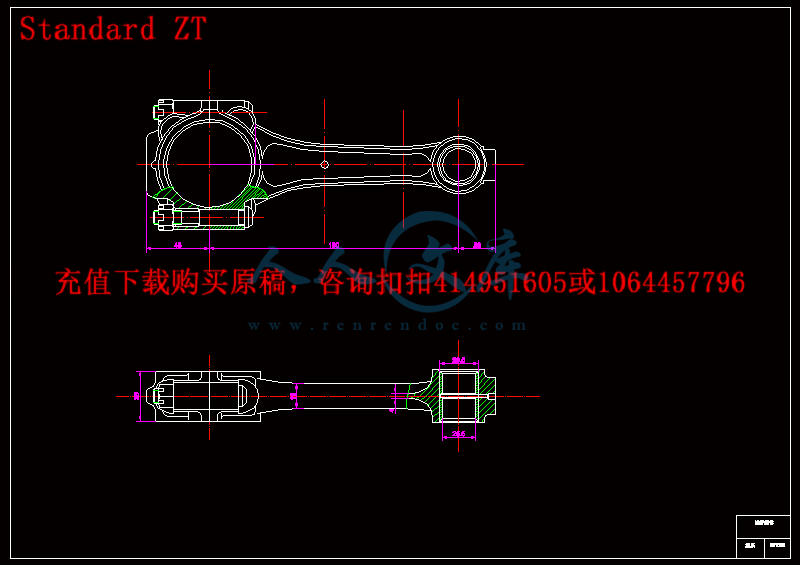摘要
连杆是发动机内部的重要零件,连杆的作用是将活塞的往复运动转变为曲轴的旋转运动,并把作用在活塞组上的燃气压力传给曲轴。连杆的作用是把活塞和 曲轴联接起来,使活塞的往复直线运动变为曲柄的回转运动,以输出动力,因此,连杆的加工精度将直接影响柴油机的性能,而工艺的选择又是直接影响精度的主要因素。连杆在工作中,除承受燃烧室燃气产生的压力外,还要承受纵向和横向的惯性力。因此,连杆在一个复杂的应力状态下工作。它既受交变的拉压应力、又受弯曲应力。
本次毕业设计针对汽车发动机连杆进行工艺设计编制及有限元分析。涉及连杆的选材、确定毛坯、拟定工艺路线、选择工艺设备。本论文通过CAD,PROE,ANSYS等对连杆进行了绘制与分析,并且对连杆的加工工艺进行了编制。得到了工艺过程和连杆的有限元分析。
关键字:连杆,工艺编制,有限元分析
ABSTRACT
Internal parts of the engine is an important link, the link is to effect reciprocation of the piston into rotary motion of the crankshaft, and the piston acting on the gas pressure to the crank set. Role of the piston rod and the crankshaft are coupled together, the reciprocating linear motion of the piston into rotary motion of the crank to the output power, therefore, the connecting rod will directly affect the precision of the performance of the diesel engine, and the process selection is direct The main factors that affect the accuracy. Link at work, in addition to withstand the pressure generated by combustion of gas, but also to withstand the longitudinal and transverse inertia force. Thus, the link to work in a complex stress state. Both by alternating tension and compression stresses, but also by bending stresses.
The graduation project preparation process design and finite element analysis for automotive engine connecting rod. Selection involves connecting rod to determine the rough, develop process route, select process equipment. In this thesis, CAD, PROE, ANSYS, etc. on the link were drawn and analyzed, and the process for connecting rod were prepared. And by a process of finite element analysis of the connecting rod.
KEY WORDS: connecting rod,process planning ,finite element analysis
目 录
第一章 绪 论- 5 -
1.1课题研究的意义- 5 -
1.2国内外现状- 5 -
1.3论文的章节安排- 6 -
第二章 连杆的工艺编制- 8 -
2.1 连杆的结构分析- 8 -
2.1.1连杆的作用- 8 -
2.1.3 连杆的工艺分析- 8 -
2.1.4 连杆的材料和毛坯选择- 10 -
2.2 连杆机械加工工艺过程- 11 -
2.3连杆工艺过程的安排- 12 -
2.3.1两个影响加工精度的主要因素- 12 -
2.3.2确定合理的夹紧方法- 13 -
2.3.3定位基准的选择- 13 -
2.3.4 连杆大小头孔的加工- 15 -
2.3.5连杆螺栓孔的加工- 15 -
2.4连杆加工工艺应考虑的问题- 16 -
2.4.1工序安排- 16 -
2.4.2定位基准- 16 -
2.4.3夹具使用- 16 -
2.4.4粗精加工时切削用量的选择原则- 17 -
2.5 连杆机械加工工艺路线- 18 -
2.6 各工序的加工余量- 27 -
第三章 连接受载荷情况下的有限元分析- 29 -
3.1连杆的有限元分析过程和结果- 29 -
第四章 全文总结- 45 -
致 谢- 46 -
参考文献- 47 -
毕业设计小结- 48 -
第一章 绪 论
1.1课题研究的意义
随着科学技术的发展,我们的生活越来越便捷。例如普遍的汽车,汽车发动机有五大件:缸体、曲轴、连杆、凸轮轴、缸盖。在今天,汽车工业的高速发展,“小体积、大功率、低油耗”的高性能发动机对连杆提出更新、更高的要求。作为高速运动件,重量要轻,减小惯性力,降低能耗和噪声,强度、刚度要高,并具有较高的韧性,连杆比要大,连杆要短。连杆是发动机内部的重要零件,连杆的作用是将活塞的往复运动转变为曲轴的旋转运动,并把作用在活塞组上的燃气压力传给曲轴。所以,连杆除上下运动外,还左右摆动作复杂的平面运动。连杆工作时,主要承受气体压力和往复惯性力所产生的交变载荷,要求它应有足够的疲劳强度和结构刚度。同时,由于连杆既是传力零件,又是运动件,不能单靠加大连杆尺寸来提高其承载能力,须综合材料选用、结构设计、热处理及表面强化等因素来确保连杆的可靠性。连杆在机器中应用之广以及它在机器中的作用和地位不言而喻。因此,本课题所研究的连杆加工工艺是非常有意义的。




 川公网安备: 51019002004831号
川公网安备: 51019002004831号